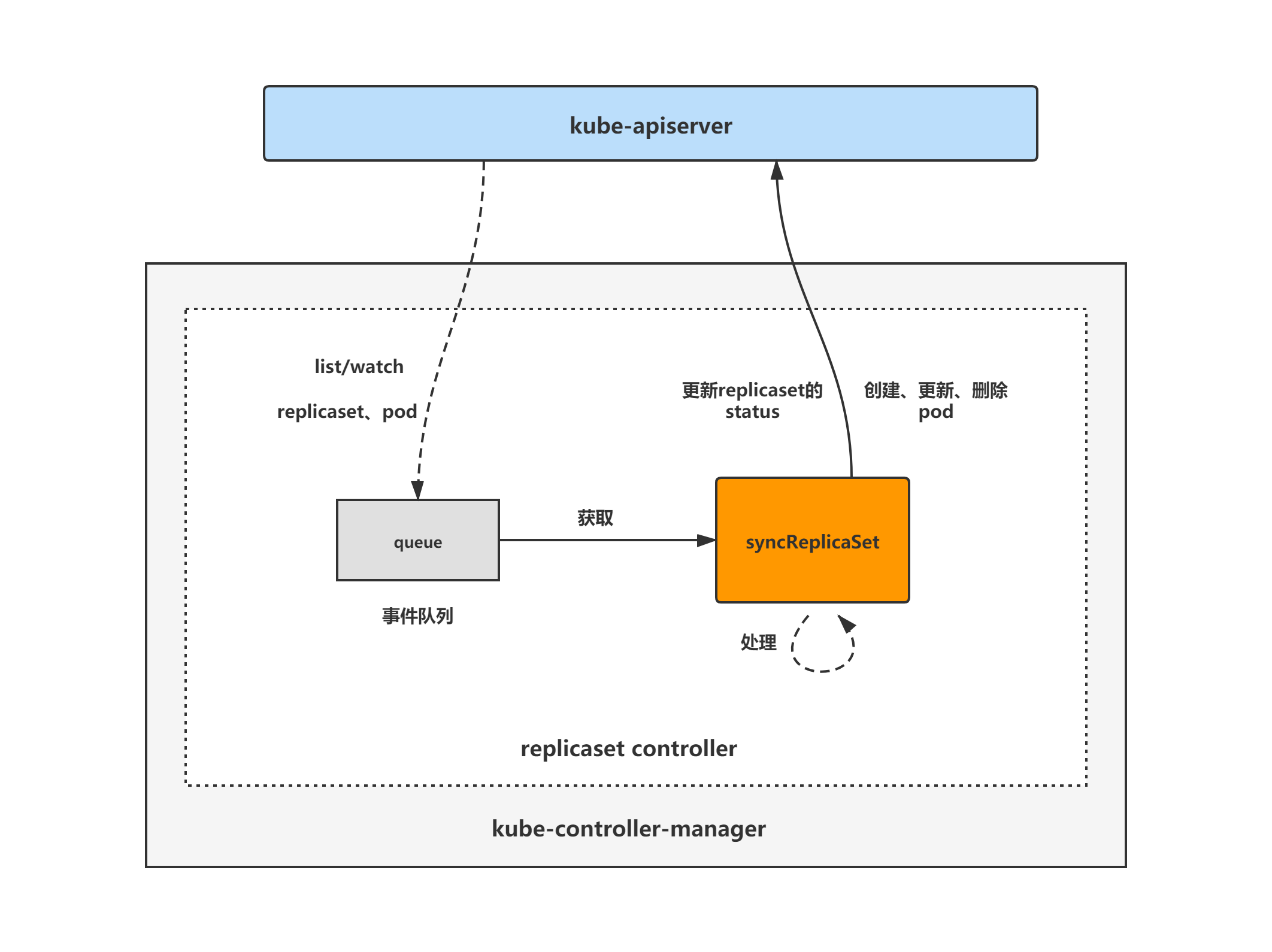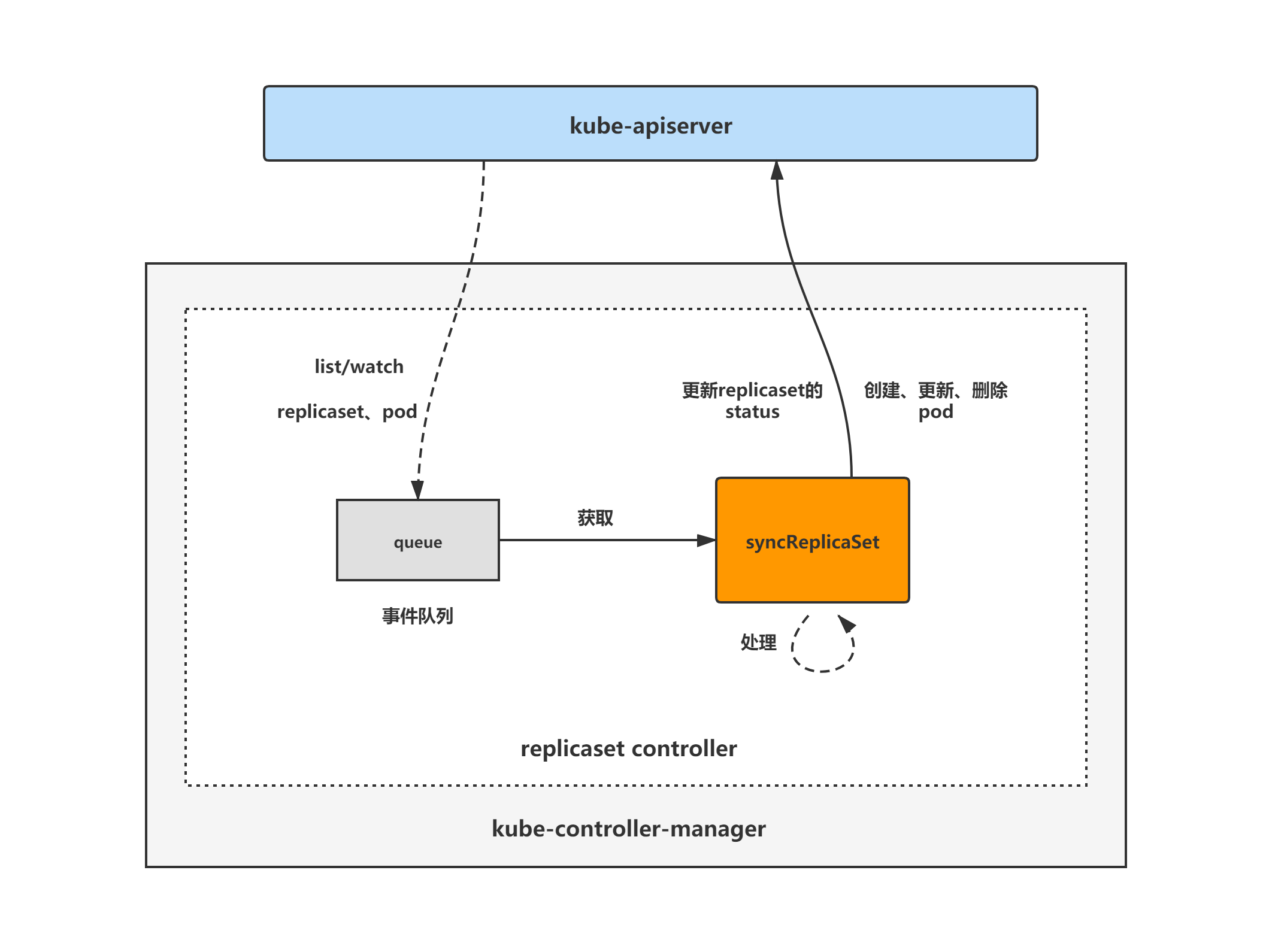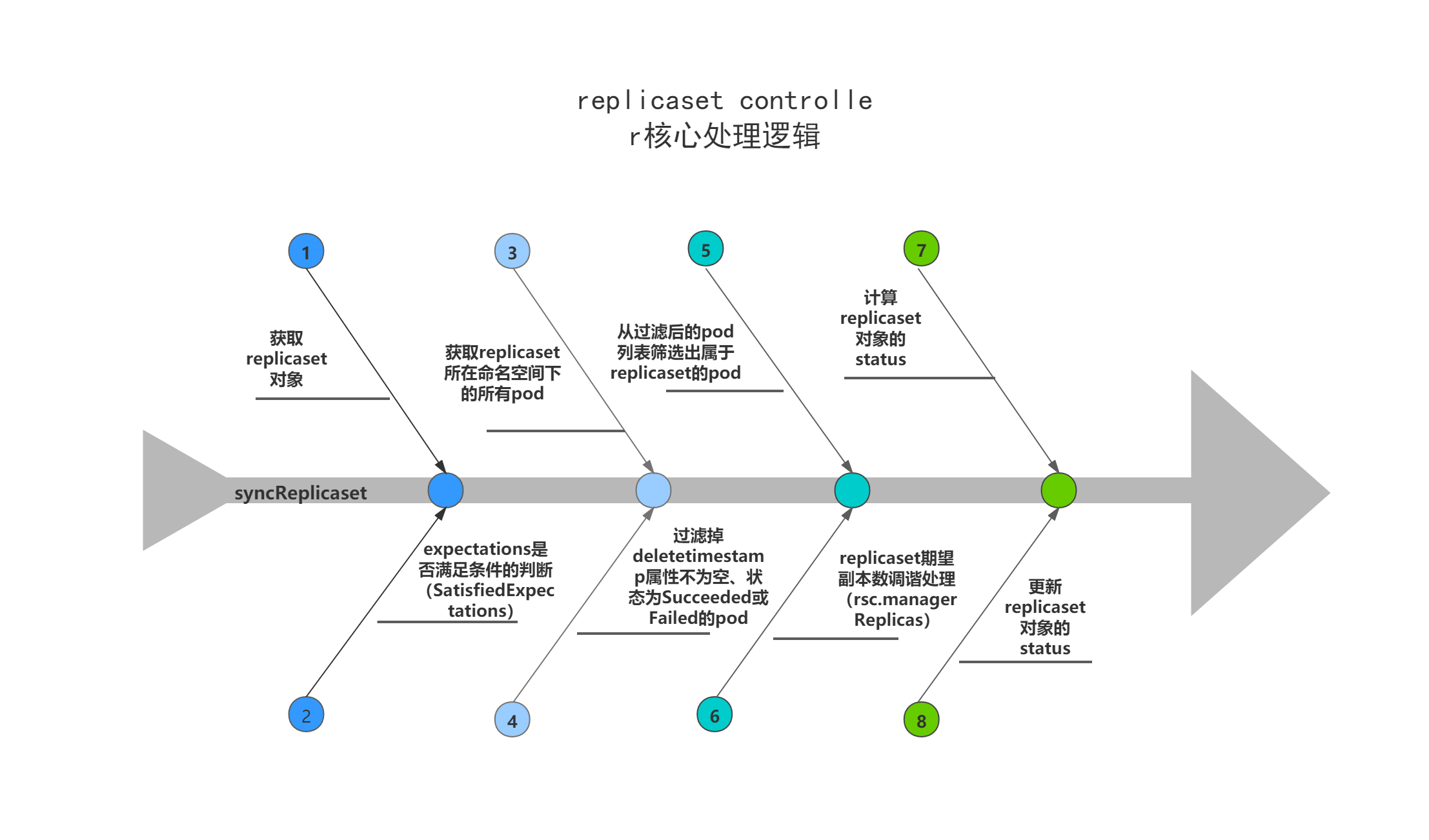k8s replicaset controller分析(2)-核心处理逻辑分析
replicaset controller分析
replicaset controller简介
replicaset controller是kube-controller-manager组件中众多控制器中的一个,是 replicaset 资源对象的控制器,其通过对replicaset、pod 2种资源的监听,当这2种资源发生变化时会触发 replicaset controller 对相应的replicaset对象进行调谐操作,从而完成replicaset期望副本数的调谐,当实际pod的数量未达到预期时创建pod,当实际pod的数量超过预期时删除pod。
replicaset controller主要作用是根据replicaset对象所期望的pod数量与现存pod数量做比较,然后根据比较结果创建/删除pod,最终使得replicaset对象所期望的pod数量与现存pod数量相等。
replicaset controller架构图
replicaset controller的大致组成和处理流程如下图,replicaset controller对pod和replicaset对象注册了event handler,当有事件时,会watch到然后将对应的replicaset对象放入到queue中,然后syncReplicaSet方法为replicaset controller调谐replicaset对象的核心处理逻辑所在,从queue中取出replicaset对象,做调谐处理。

replicaset controller分析分为3大块进行,分别是:
(1)replicaset controller初始化和启动分析;
(2)replicaset controller核心处理逻辑分析;
(3)replicaset controller expectations机制分析。
本篇博客进行replicaset controller核心处理逻辑分析。
replicaset controller核心处理逻辑分析
基于v1.17.4
经过前面分析的replicaset controller的初始化与启动,知道了replicaset controller监听replicaset、pod对象的add、update与delete事件,然后对replicaset对象做相应的调谐处理,这里来接着分析replicaset controller的调谐处理(核心处理)逻辑,从rsc.syncHandler作为入口进行分析。
rsc.syncHandler
rsc.syncHandler即rsc.syncReplicaSet方法,主要逻辑:
(1)获取replicaset对象以及关联的pod对象列表;
(2)调用rsc.expectations.SatisfiedExpectations,判断上一轮对replicaset期望副本的创删操作是否完成,也可以认为是判断上一次对replicaset对象的调谐操作中,调用的rsc.manageReplicas方法是否执行完成;
(3)如果上一轮对replicaset期望副本的创删操作已经完成,且replicaset对象的DeletionTimestamp字段为nil,则调用rsc.manageReplicas做replicaset期望副本的核心调谐处理,即创删pod;
(4)调用calculateStatus计算replicaset的status,并更新。
// syncReplicaSet will sync the ReplicaSet with the given key if it has had its expectations fulfilled,// meaning it did not expect to see any more of its pods created or deleted. This function is not meant to be// invoked concurrently with the same key.func (rsc *ReplicaSetController) syncReplicaSet(key string) error {startTime := time.Now()defer func() {klog.V(4).Infof("Finished syncing %v %q (%v)", rsc.Kind, key, time.Since(startTime))}()namespace, name, err := cache.SplitMetaNamespaceKey(key)if err != nil {return err}rs, err := rsc.rsLister.ReplicaSets(namespace).Get(name)if errors.IsNotFound(err) {klog.V(4).Infof("%v %v has been deleted", rsc.Kind, key)rsc.expectations.DeleteExpectations(key)return nil}if err != nil {return err}rsNeedsSync := rsc.expectations.SatisfiedExpectations(key)selector, err := metav1.LabelSelectorAsSelector(rs.Spec.Selector)if err != nil {utilruntime.HandleError(fmt.Errorf("error converting pod selector to selector: %v", err))return nil}// list all pods to include the pods that don't match the rs`s selector// anymore but has the stale controller ref.// TODO: Do the List and Filter in a single pass, or use an index.allPods, err := rsc.podLister.Pods(rs.Namespace).List(labels.Everything())if err != nil {return err}// Ignore inactive pods.filteredPods := controller.FilterActivePods(allPods)// NOTE: filteredPods are pointing to objects from cache - if you need to// modify them, you need to copy it first.filteredPods, err = rsc.claimPods(rs, selector, filteredPods)if err != nil {return err}var manageReplicasErr errorif rsNeedsSync && rs.DeletionTimestamp == nil {manageReplicasErr = rsc.manageReplicas(filteredPods, rs)}rs = rs.DeepCopy()newStatus := calculateStatus(rs, filteredPods, manageReplicasErr)// Always updates status as pods come up or die.updatedRS, err := updateReplicaSetStatus(rsc.kubeClient.AppsV1().ReplicaSets(rs.Namespace), rs, newStatus)if err != nil {// Multiple things could lead to this update failing. Requeuing the replica set ensures// Returning an error causes a requeue without forcing a hotloopreturn err}// Resync the ReplicaSet after MinReadySeconds as a last line of defense to guard against clock-skew.if manageReplicasErr == nil && updatedRS.Spec.MinReadySeconds > 0 &&updatedRS.Status.ReadyReplicas == *(updatedRS.Spec.Replicas) &&updatedRS.Status.AvailableReplicas != *(updatedRS.Spec.Replicas) {rsc.queue.AddAfter(key, time.Duration(updatedRS.Spec.MinReadySeconds)*time.Second)}return manageReplicasErr}
1 rsc.expectations.SatisfiedExpectations
该方法主要是判断上一轮对replicaset期望副本的创删操作是否完成,也可以认为是判断上一次对replicaset对象的调谐操作中,调用的rsc.manageReplicas方法是否执行完成。待上一次创建删除pod的操作完成后,才能进行下一次的rsc.manageReplicas方法调用。
若某replicaset对象的调谐中从未调用过rsc.manageReplicas方法,或上一轮调谐时创建/删除pod的数量已达成或调用rsc.manageReplicas后已达到超时期限(超时时间5分钟),则返回true,代表上一次创建删除pod的操作完成,可以进行下一次的rsc.manageReplicas方法调用,否则返回false。
expectations记录了replicaset对象在某一次调谐中期望创建/删除的pod数量,pod创建/删除完成后,该期望数会相应的减少,当期望创建/删除的pod数量小于等于0时,说明上一次调谐中期望创建/删除的pod数量已经达到,返回true。
关于Expectations机制后面会做详细分析。
// pkg/controller/controller_utils.gofunc (r *ControllerExpectations) SatisfiedExpectations(controllerKey string) bool {if exp, exists, err := r.GetExpectations(controllerKey); exists {if exp.Fulfilled() {klog.V(4).Infof("Controller expectations fulfilled %#v", exp)return true} else if exp.isExpired() {klog.V(4).Infof("Controller expectations expired %#v", exp)return true} else {klog.V(4).Infof("Controller still waiting on expectations %#v", exp)return false}} else if err != nil {klog.V(2).Infof("Error encountered while checking expectations %#v, forcing sync", err)} else {// When a new controller is created, it doesn't have expectations.// When it doesn't see expected watch events for > TTL, the expectations expire.// - In this case it wakes up, creates/deletes controllees, and sets expectations again.// When it has satisfied expectations and no controllees need to be created/destroyed > TTL, the expectations expire.// - In this case it continues without setting expectations till it needs to create/delete controllees.klog.V(4).Infof("Controller %v either never recorded expectations, or the ttl expired.", controllerKey)}// Trigger a sync if we either encountered and error (which shouldn't happen since we're// getting from local store) or this controller hasn't established expectations.return true}func (exp *ControlleeExpectations) isExpired() bool {return clock.RealClock{}.Since(exp.timestamp) > ExpectationsTimeout // ExpectationsTimeout = 5 * time.Minute}
2 核心创建删除pod方法-rsc.manageReplicas
核心创建删除pod方法,主要是根据replicaset所期望的pod数量与现存pod数量做比较,然后根据比较结果来创建/删除pod,最终使得replicaset对象所期望的pod数量与现存pod数量相等,需要特别注意的是,每一次调用rsc.manageReplicas方法,创建/删除pod的个数上限为500。
在replicaset对象的调谐中,rsc.manageReplicas方法不一定每一次都会调用执行,只有当rsc.expectations.SatisfiedExpectations方法返回true,且replicaset对象的DeletionTimestamp属性为空时,才会进行rsc.manageReplicas方法的调用。
先简单的看一下代码,代码后面会做详细的逻辑分析。
// pkg/controller/replicaset/replica_set.gofunc (rsc *ReplicaSetController) manageReplicas(filteredPods []*v1.Pod, rs *apps.ReplicaSet) error {diff := len(filteredPods) - int(*(rs.Spec.Replicas))rsKey, err := controller.KeyFunc(rs)if err != nil {utilruntime.HandleError(fmt.Errorf("Couldn't get key for %v %#v: %v", rsc.Kind, rs, err))return nil}if diff < 0 {diff *= -1if diff > rsc.burstReplicas {diff = rsc.burstReplicas}// TODO: Track UIDs of creates just like deletes. The problem currently// is we'd need to wait on the result of a create to record the pod's// UID, which would require locking *across* the create, which will turn// into a performance bottleneck. We should generate a UID for the pod// beforehand and store it via ExpectCreations.rsc.expectations.ExpectCreations(rsKey, diff)glog.V(2).Infof("Too few replicas for %v %s/%s, need %d, creating %d", rsc.Kind, rs.Namespace, rs.Name, *(rs.Spec.Replicas), diff)// Batch the pod creates. Batch sizes start at SlowStartInitialBatchSize// and double with each successful iteration in a kind of "slow start".// This handles attempts to start large numbers of pods that would// likely all fail with the same error. For example a project with a// low quota that attempts to create a large number of pods will be// prevented from spamming the API service with the pod create requests// after one of its pods fails. Conveniently, this also prevents the// event spam that those failures would generate.successfulCreations, err := slowStartBatch(diff, controller.SlowStartInitialBatchSize, func() error {boolPtr := func(b bool) *bool { return &b }controllerRef := &metav1.OwnerReference{APIVersion: rsc.GroupVersion().String(),Kind: rsc.Kind,Name: rs.Name,UID: rs.UID,BlockOwnerDeletion: boolPtr(true),Controller: boolPtr(true),}err := rsc.podControl.CreatePodsWithControllerRef(rs.Namespace, &rs.Spec.Template, rs, controllerRef)if err != nil && errors.IsTimeout(err) {// Pod is created but its initialization has timed out.// If the initialization is successful eventually, the// controller will observe the creation via the informer.// If the initialization fails, or if the pod keeps// uninitialized for a long time, the informer will not// receive any update, and the controller will create a new// pod when the expectation expires.return nil}return err})// Any skipped pods that we never attempted to start shouldn't be expected.// The skipped pods will be retried later. The next controller resync will// retry the slow start process.if skippedPods := diff - successfulCreations; skippedPods > 0 {glog.V(2).Infof("Slow-start failure. Skipping creation of %d pods, decrementing expectations for %v %v/%v", skippedPods, rsc.Kind, rs.Namespace, rs.Name)for i := 0; i < skippedPods; i++ {// Decrement the expected number of creates because the informer won't observe this podrsc.expectations.CreationObserved(rsKey)}}return err} else if diff > 0 {if diff > rsc.burstReplicas {diff = rsc.burstReplicas}glog.V(2).Infof("Too many replicas for %v %s/%s, need %d, deleting %d", rsc.Kind, rs.Namespace, rs.Name, *(rs.Spec.Replicas), diff)// Choose which Pods to delete, preferring those in earlier phases of startup.podsToDelete := getPodsToDelete(filteredPods, diff)// Snapshot the UIDs (ns/name) of the pods we're expecting to see// deleted, so we know to record their expectations exactly once either// when we see it as an update of the deletion timestamp, or as a delete.// Note that if the labels on a pod/rs change in a way that the pod gets// orphaned, the rs will only wake up after the expectations have// expired even if other pods are deleted.rsc.expectations.ExpectDeletions(rsKey, getPodKeys(podsToDelete))errCh := make(chan error, diff)var wg sync.WaitGroupwg.Add(diff)for _, pod := range podsToDelete {go func(targetPod *v1.Pod) {defer wg.Done()if err := rsc.podControl.DeletePod(rs.Namespace, targetPod.Name, rs); err != nil {// Decrement the expected number of deletes because the informer won't observe this deletionpodKey := controller.PodKey(targetPod)glog.V(2).Infof("Failed to delete %v, decrementing expectations for %v %s/%s", podKey, rsc.Kind, rs.Namespace, rs.Name)rsc.expectations.DeletionObserved(rsKey, podKey)errCh <- err}}(pod)}wg.Wait()select {case err := <-errCh:// all errors have been reported before and they're likely to be the same, so we'll only return the first one we hit.if err != nil {return err}default:}}return nil}
diff = 现存pod数量 - 期望的pod数量
diff := len(filteredPods) - int(*(rs.Spec.Replicas))
(1)当现存pod数量比期望的少时,需要创建pod,进入创建pod的逻辑代码块。
(2)当现存pod数量比期望的多时,需要删除pod,进入删除pod的逻辑代码块。
一次同步操作中批量创建或删除pod的个数上限为rsc.burstReplicas,即500个。
// pkg/controller/replicaset/replica_set.goconst (// Realistic value of the burstReplica field for the replica set manager based off// performance requirements for kubernetes 1.0.BurstReplicas = 500// The number of times we retry updating a ReplicaSet's status.statusUpdateRetries = 1)
if diff > rsc.burstReplicas {diff = rsc.burstReplicas}
接下来分析一下创建/删除pod的逻辑代码块。
2.1 创建pod逻辑代码块
主要逻辑:
(1)运算获取需要创建的pod数量,并设置数量上限500;
(2)调用rsc.expectations.ExpectCreations,将本轮调谐期望创建的pod数量设置进expectations;
(3)调用slowStartBatch函数来对pod进行创建逻辑处理;
(4)调用slowStartBatch函数完成后,计算获取创建失败的pod的数量,然后调用相应次数的rsc.expectations.CreationObserved方法,减去本轮调谐中期望创建的pod数量。
为什么要减呢?因为expectations记录了replicaset对象在某一次调谐中期望创建/删除的pod数量,pod创建/删除完成后,replicaset controller会watch到pod的创建/删除事件,从而调用rsc.expectations.CreationObserved方法来使期望创建/删除的pod数量减少。当有相应数量的pod创建/删除失败后,replicaset controller是不会watch到相应的pod创建/删除事件的,所以必须把本轮调谐期望创建/删除的pod数量做相应的减法,否则本轮调谐中的期望创建/删除pod数量永远不可能小于等于0,这样的话,rsc.expectations.SatisfiedExpectations方法就只会等待expectations超时期限到达才会返回true了。
diff *= -1if diff > rsc.burstReplicas {diff = rsc.burstReplicas}rsc.expectations.ExpectCreations(rsKey, diff)glog.V(2).Infof("Too few replicas for %v %s/%s, need %d, creating %d", rsc.Kind, rs.Namespace, rs.Name, *(rs.Spec.Replicas), diff)successfulCreations, err := slowStartBatch(diff, controller.SlowStartInitialBatchSize, func() error {boolPtr := func(b bool) *bool { return &b }controllerRef := &metav1.OwnerReference{APIVersion: rsc.GroupVersion().String(),Kind: rsc.Kind,Name: rs.Name,UID: rs.UID,BlockOwnerDeletion: boolPtr(true),Controller: boolPtr(true),}err := rsc.podControl.CreatePodsWithControllerRef(rs.Namespace, &rs.Spec.Template, rs, controllerRef)if err != nil && errors.IsTimeout(err) {// Pod is created but its initialization has timed out.// If the initialization is successful eventually, the// controller will observe the creation via the informer.// If the initialization fails, or if the pod keeps// uninitialized for a long time, the informer will not// receive any update, and the controller will create a new// pod when the expectation expires.return nil}return err})if skippedPods := diff - successfulCreations; skippedPods > 0 {glog.V(2).Infof("Slow-start failure. Skipping creation of %d pods, decrementing expectations for %v %v/%v", skippedPods, rsc.Kind, rs.Namespace, rs.Name)for i := 0; i < skippedPods; i++ {// Decrement the expected number of creates because the informer won't observe this podrsc.expectations.CreationObserved(rsKey)}}return err
2.1.1 slowStartBatch
来看到slowStartBatch,可以看到创建pod的算法为:
(1)每次批量创建的 pod 数依次为 1、2、4、8......,呈指数级增长,起与要创建的pod数量相同的goroutine来负责创建pod。
(2)创建pod按1、2、4、8...的递增趋势分多批次进行,若某批次创建pod有失败的(如apiserver限流,丢弃请求等,注意:超时除外,因为initialization处理有可能超时),则后续批次不再进行,结束本次函数调用。
// pkg/controller/replicaset/replica_set.go// slowStartBatch tries to call the provided function a total of 'count' times,// starting slow to check for errors, then speeding up if calls succeed.//// It groups the calls into batches, starting with a group of initialBatchSize.// Within each batch, it may call the function multiple times concurrently.//// If a whole batch succeeds, the next batch may get exponentially larger.// If there are any failures in a batch, all remaining batches are skipped// after waiting for the current batch to complete.//// It returns the number of successful calls to the function.func slowStartBatch(count int, initialBatchSize int, fn func() error) (int, error) {remaining := countsuccesses := 0for batchSize := integer.IntMin(remaining, initialBatchSize); batchSize > 0; batchSize = integer.IntMin(2*batchSize, remaining) {errCh := make(chan error, batchSize)var wg sync.WaitGroupwg.Add(batchSize)for i := 0; i < batchSize; i++ {go func() {defer wg.Done()if err := fn(); err != nil {errCh <- err}}()}wg.Wait()curSuccesses := batchSize - len(errCh)successes += curSuccessesif len(errCh) > 0 {return successes, <-errCh}remaining -= batchSize}return successes, nil}
rsc.podControl.CreatePodsWithControllerRef
前面定义的创建pod时调用的方法为rsc.podControl.CreatePodsWithControllerRef。
func (r RealPodControl) CreatePodsWithControllerRef(namespace string, template *v1.PodTemplateSpec, controllerObject runtime.Object, controllerRef *metav1.OwnerReference) error {if err := validateControllerRef(controllerRef); err != nil {return err}return r.createPods("", namespace, template, controllerObject, controllerRef)}func (r RealPodControl) createPods(nodeName, namespace string, template *v1.PodTemplateSpec, object runtime.Object, controllerRef *metav1.OwnerReference) error {pod, err := GetPodFromTemplate(template, object, controllerRef)if err != nil {return err}if len(nodeName) != 0 {pod.Spec.NodeName = nodeName}if len(labels.Set(pod.Labels)) == 0 {return fmt.Errorf("unable to create pods, no labels")}newPod, err := r.KubeClient.CoreV1().Pods(namespace).Create(pod)if err != nil {// only send an event if the namespace isn't terminatingif !apierrors.HasStatusCause(err, v1.NamespaceTerminatingCause) {r.Recorder.Eventf(object, v1.EventTypeWarning, FailedCreatePodReason, "Error creating: %v", err)}return err}accessor, err := meta.Accessor(object)if err != nil {klog.Errorf("parentObject does not have ObjectMeta, %v", err)return nil}klog.V(4).Infof("Controller %v created pod %v", accessor.GetName(), newPod.Name)r.Recorder.Eventf(object, v1.EventTypeNormal, SuccessfulCreatePodReason, "Created pod: %v", newPod.Name)return nil}
2.2 删除逻辑代码块
主要逻辑:
(1)运算获取需要删除的pod数量,并设置数量上限500;
(2)根据要缩容删除的pod数量,先调用getPodsToDelete函数找出需要删除的pod列表;
(3)调用rsc.expectations.ExpectCreations,将本轮调谐期望删除的pod数量设置进expectations;
(4)每个pod拉起一个goroutine,调用rsc.podControl.DeletePod来删除该pod;
(5)对于删除失败的pod,会调用rsc.expectations.DeletionObserved方法,减去本轮调谐中期望创建的pod数量。
至于为什么要减,原因跟上面创建逻辑代码块中分析的一样。
(6)等待所有gorouutine完成,return返回。
if diff > rsc.burstReplicas {diff = rsc.burstReplicas}glog.V(2).Infof("Too many replicas for %v %s/%s, need %d, deleting %d", rsc.Kind, rs.Namespace, rs.Name, *(rs.Spec.Replicas), diff)// Choose which Pods to delete, preferring those in earlier phases of startup.podsToDelete := getPodsToDelete(filteredPods, diff)rsc.expectations.ExpectDeletions(rsKey, getPodKeys(podsToDelete))errCh := make(chan error, diff)var wg sync.WaitGroupwg.Add(diff)for _, pod := range podsToDelete {go func(targetPod *v1.Pod) {defer wg.Done()if err := rsc.podControl.DeletePod(rs.Namespace, targetPod.Name, rs); err != nil {// Decrement the expected number of deletes because the informer won't observe this deletionpodKey := controller.PodKey(targetPod)glog.V(2).Infof("Failed to delete %v, decrementing expectations for %v %s/%s", podKey, rsc.Kind, rs.Namespace, rs.Name)rsc.expectations.DeletionObserved(rsKey, podKey)errCh <- err}}(pod)}wg.Wait()select {case err := <-errCh:// all errors have been reported before and they're likely to be the same, so we'll only return the first one we hit.if err != nil {return err}default:}
2.2.1 getPodsToDelete
getPodsToDelete:根据要缩容删除的pod数量,然后返回需要删除的pod列表。
// pkg/controller/replicaset/replica_set.gofunc getPodsToDelete(filteredPods, relatedPods []*v1.Pod, diff int) []*v1.Pod {// No need to sort pods if we are about to delete all of them.// diff will always be <= len(filteredPods), so not need to handle > case.if diff < len(filteredPods) {podsWithRanks := getPodsRankedByRelatedPodsOnSameNode(filteredPods, relatedPods)sort.Sort(podsWithRanks)}return filteredPods[:diff]}func getPodsRankedByRelatedPodsOnSameNode(podsToRank, relatedPods []*v1.Pod) controller.ActivePodsWithRanks {podsOnNode := make(map[string]int)for _, pod := range relatedPods {if controller.IsPodActive(pod) {podsOnNode[pod.Spec.NodeName]++}}ranks := make([]int, len(podsToRank))for i, pod := range podsToRank {ranks[i] = podsOnNode[pod.Spec.NodeName]}return controller.ActivePodsWithRanks{Pods: podsToRank, Rank: ranks}}
筛选要删除的pod逻辑
按照下面的排序规则,从上到下进行排序,各个条件相互互斥,符合其中一个条件则排序完成:
(1)优先删除没有绑定node的pod;
(2)优先删除处于Pending状态的pod,然后是Unknown,最后才是Running;
(3)优先删除Not ready的pod,然后才是ready的pod;
(4)按同node上所属replicaset的pod数量排序,优先删除所属replicaset的pod数量多的node上的pod;
(5)按pod ready的时间排序,优先删除ready时间最短的pod;
(6)优先删除pod中容器重启次数较多的pod;
(7)按pod创建时间排序,优先删除创建时间最短的pod。
// pkg/controller/controller_utils.gofunc (s ActivePodsWithRanks) Less(i, j int) bool {// 1. Unassigned < assigned// If only one of the pods is unassigned, the unassigned one is smallerif s.Pods[i].Spec.NodeName != s.Pods[j].Spec.NodeName && (len(s.Pods[i].Spec.NodeName) == 0 || len(s.Pods[j].Spec.NodeName) == 0) {return len(s.Pods[i].Spec.NodeName) == 0}// 2. PodPending < PodUnknown < PodRunningif podPhaseToOrdinal[s.Pods[i].Status.Phase] != podPhaseToOrdinal[s.Pods[j].Status.Phase] {return podPhaseToOrdinal[s.Pods[i].Status.Phase] < podPhaseToOrdinal[s.Pods[j].Status.Phase]}// 3. Not ready < ready// If only one of the pods is not ready, the not ready one is smallerif podutil.IsPodReady(s.Pods[i]) != podutil.IsPodReady(s.Pods[j]) {return !podutil.IsPodReady(s.Pods[i])}// 4. Doubled up < not doubled up// If one of the two pods is on the same node as one or more additional// ready pods that belong to the same replicaset, whichever pod has more// colocated ready pods is lessif s.Rank[i] != s.Rank[j] {return s.Rank[i] > s.Rank[j]}// TODO: take availability into account when we push minReadySeconds information from deployment into pods,// see https://github.com/kubernetes/kubernetes/issues/22065// 5. Been ready for empty time < less time < more time// If both pods are ready, the latest ready one is smallerif podutil.IsPodReady(s.Pods[i]) && podutil.IsPodReady(s.Pods[j]) {readyTime1 := podReadyTime(s.Pods[i])readyTime2 := podReadyTime(s.Pods[j])if !readyTime1.Equal(readyTime2) {return afterOrZero(readyTime1, readyTime2)}}// 6. Pods with containers with higher restart counts < lower restart countsif maxContainerRestarts(s.Pods[i]) != maxContainerRestarts(s.Pods[j]) {return maxContainerRestarts(s.Pods[i]) > maxContainerRestarts(s.Pods[j])}// 7. Empty creation time pods < newer pods < older podsif !s.Pods[i].CreationTimestamp.Equal(&s.Pods[j].CreationTimestamp) {return afterOrZero(&s.Pods[i].CreationTimestamp, &s.Pods[j].CreationTimestamp)}return false}
2.2.2 rsc.podControl.DeletePod
删除pod的方法。
// pkg/controller/controller_utils.gofunc (r RealPodControl) DeletePod(namespace string, podID string, object runtime.Object) error {accessor, err := meta.Accessor(object)if err != nil {return fmt.Errorf("object does not have ObjectMeta, %v", err)}klog.V(2).Infof("Controller %v deleting pod %v/%v", accessor.GetName(), namespace, podID)if err := r.KubeClient.CoreV1().Pods(namespace).Delete(podID, nil); err != nil && !apierrors.IsNotFound(err) {r.Recorder.Eventf(object, v1.EventTypeWarning, FailedDeletePodReason, "Error deleting: %v", err)return fmt.Errorf("unable to delete pods: %v", err)}r.Recorder.Eventf(object, v1.EventTypeNormal, SuccessfulDeletePodReason, "Deleted pod: %v", podID)return nil}
3 calculateStatus
calculateStatus函数计算并返回replicaset对象的status。
怎么计算status呢?
(1)根据现存pod数量、Ready状态的pod数量、availabel状态的pod数量等,给replicaset对象的status的Replicas、ReadyReplicas、AvailableReplicas等字段赋值;
(2)根据replicaset对象现有status中的condition配置以及前面调用rsc.manageReplicas方法后是否有错误,来决定给status新增condition或移除condition,conditionType为ReplicaFailure。
当调用rsc.manageReplicas方法出错,且replicaset对象的status中,没有conditionType为ReplicaFailure的condition,则新增conditionType为ReplicaFailure的condition,表示该replicaset创建/删除pod出错;
当调用rsc.manageReplicas方法没有任何错误,且replicaset对象的status中,有conditionType为ReplicaFailure的condition,则去除该condition,表示该replicaset创建/删除pod成功。
func calculateStatus(rs *apps.ReplicaSet, filteredPods []*v1.Pod, manageReplicasErr error) apps.ReplicaSetStatus {newStatus := rs.Status// Count the number of pods that have labels matching the labels of the pod// template of the replica set, the matching pods may have more// labels than are in the template. Because the label of podTemplateSpec is// a superset of the selector of the replica set, so the possible// matching pods must be part of the filteredPods.fullyLabeledReplicasCount := 0readyReplicasCount := 0availableReplicasCount := 0templateLabel := labels.Set(rs.Spec.Template.Labels).AsSelectorPreValidated()for _, pod := range filteredPods {if templateLabel.Matches(labels.Set(pod.Labels)) {fullyLabeledReplicasCount++}if podutil.IsPodReady(pod) {readyReplicasCount++if podutil.IsPodAvailable(pod, rs.Spec.MinReadySeconds, metav1.Now()) {availableReplicasCount++}}}failureCond := GetCondition(rs.Status, apps.ReplicaSetReplicaFailure)if manageReplicasErr != nil && failureCond == nil {var reason stringif diff := len(filteredPods) - int(*(rs.Spec.Replicas)); diff < 0 {reason = "FailedCreate"} else if diff > 0 {reason = "FailedDelete"}cond := NewReplicaSetCondition(apps.ReplicaSetReplicaFailure, v1.ConditionTrue, reason, manageReplicasErr.Error())SetCondition(&newStatus, cond)} else if manageReplicasErr == nil && failureCond != nil {RemoveCondition(&newStatus, apps.ReplicaSetReplicaFailure)}newStatus.Replicas = int32(len(filteredPods))newStatus.FullyLabeledReplicas = int32(fullyLabeledReplicasCount)newStatus.ReadyReplicas = int32(readyReplicasCount)newStatus.AvailableReplicas = int32(availableReplicasCount)return newStatus}
4 updateReplicaSetStatus
主要逻辑:
(1)判断新计算出来的status中的各个属性如Replicas、ReadyReplicas、AvailableReplicas以及Conditions是否与现存replicaset对象的status中的一致,一致则不用做更新操作,直接return;
(2)调用c.UpdateStatus更新replicaset的status。
// pkg/controller/replicaset/replica_set_utils.gofunc updateReplicaSetStatus(c appsclient.ReplicaSetInterface, rs *apps.ReplicaSet, newStatus apps.ReplicaSetStatus) (*apps.ReplicaSet, error) {// This is the steady state. It happens when the ReplicaSet doesn't have any expectations, since// we do a periodic relist every 30s. If the generations differ but the replicas are// the same, a caller might've resized to the same replica count.if rs.Status.Replicas == newStatus.Replicas &&rs.Status.FullyLabeledReplicas == newStatus.FullyLabeledReplicas &&rs.Status.ReadyReplicas == newStatus.ReadyReplicas &&rs.Status.AvailableReplicas == newStatus.AvailableReplicas &&rs.Generation == rs.Status.ObservedGeneration &&reflect.DeepEqual(rs.Status.Conditions, newStatus.Conditions) {return rs, nil}// Save the generation number we acted on, otherwise we might wrongfully indicate// that we've seen a spec update when we retry.// TODO: This can clobber an update if we allow multiple agents to write to the// same status.newStatus.ObservedGeneration = rs.Generationvar getErr, updateErr errorvar updatedRS *apps.ReplicaSetfor i, rs := 0, rs; ; i++ {klog.V(4).Infof(fmt.Sprintf("Updating status for %v: %s/%s, ", rs.Kind, rs.Namespace, rs.Name) +fmt.Sprintf("replicas %d->%d (need %d), ", rs.Status.Replicas, newStatus.Replicas, *(rs.Spec.Replicas)) +fmt.Sprintf("fullyLabeledReplicas %d->%d, ", rs.Status.FullyLabeledReplicas, newStatus.FullyLabeledReplicas) +fmt.Sprintf("readyReplicas %d->%d, ", rs.Status.ReadyReplicas, newStatus.ReadyReplicas) +fmt.Sprintf("availableReplicas %d->%d, ", rs.Status.AvailableReplicas, newStatus.AvailableReplicas) +fmt.Sprintf("sequence No: %v->%v", rs.Status.ObservedGeneration, newStatus.ObservedGeneration))rs.Status = newStatusupdatedRS, updateErr = c.UpdateStatus(rs)if updateErr == nil {return updatedRS, nil}// Stop retrying if we exceed statusUpdateRetries - the replicaSet will be requeued with a rate limit.if i >= statusUpdateRetries {break}// Update the ReplicaSet with the latest resource version for the next pollif rs, getErr = c.Get(rs.Name, metav1.GetOptions{}); getErr != nil {// If the GET fails we can't trust status.Replicas anymore. This error// is bound to be more interesting than the update failure.return nil, getErr}}return nil, updateErr}
c.UpdateStatus
// staging/src/k8s.io/client-go/kubernetes/typed/apps/v1/replicaset.gofunc (c *replicaSets) UpdateStatus(replicaSet *v1.ReplicaSet) (result *v1.ReplicaSet, err error) {result = &v1.ReplicaSet{}err = c.client.Put().Namespace(c.ns).Resource("replicasets").Name(replicaSet.Name).SubResource("status").Body(replicaSet).Do().Into(result)return}
总结
replicaset controller架构图
replicaset controller的大致组成和处理流程如下图,replicaset controller对pod和replicaset对象注册了event handler,当有事件时,会watch到然后将对应的replicaset对象放入到queue中,然后syncReplicaSet方法为replicaset controller调谐replicaset对象的核心处理逻辑所在,从queue中取出replicaset对象,做调谐处理。

replicaset controller核心处理逻辑
replicaset controller的核心处理逻辑是根据replicaset对象里期望的pod数量以及现存pod数量的比较,当期望pod数量比现存pod数量多时,调用创建pod算法创建出新的pod,直至达到期望数量;当期望pod数量比现存pod数量少时,调用删除pod算法,并根据一定的策略对现存pod列表做排序,从中按顺序选择多余的pod然后删除,直至达到期望数量。

replicaset controller创建pod算法
replicaset controller创建pod的算法是,按1、2、4、8...的递增趋势分多批次进行(每次调谐中创建pod的数量上限为500个,超过上限的会在下次调谐中再创建),若某批次创建pod有失败的(如apiserver限流,丢弃请求等,注意:超时除外,因为initialization处理有可能超时),则后续批次的pod创建不再进行,需等待该repliaset对象下次调谐时再触发该pod创建算法,进行pod的创建,直至达到期望数量。
replicaset controller删除pod算法
replicaset controller删除pod的算法是,先根据一定的策略将现存pod列表做排序,然后按顺序从中选择指定数量的pod,拉起与要删除的pod数量相同的goroutine来删除pod(每次调谐中删除pod的数量上限为500个),并等待所有goroutine执行完成。删除pod有失败的(如apiserver限流,丢弃请求)或超过500上限的部分,需等待该repliaset对象下次调谐时再触发该pod删除算法,进行pod的删除,直至达到期望数量。
筛选要删除的pod逻辑
按照下面的排序规则,从上到下进行排序,各个条件相互互斥,符合其中一个条件则排序完成:
(1)优先删除没有绑定node的pod;
(2)优先删除处于Pending状态的pod,然后是Unknown,最后才是Running;
(3)优先删除Not ready的pod,然后才是ready的pod;
(4)按同node上所属replicaset的pod数量排序,优先删除所属replicaset的pod数量多的node上的pod;
(5)按pod ready的时间排序,优先删除ready时间最短的pod;
(6)优先删除pod中容器重启次数较多的pod;
(7)按pod创建时间排序,优先删除创建时间最短的pod。
expectations机制
关于expectations机制的分析,会在下一篇博客中进行。
k8s replicaset controller分析(2)-核心处理逻辑分析的更多相关文章
- k8s replicaset controller分析(1)-初始化与启动分析
replicaset controller分析 replicaset controller简介 replicaset controller是kube-controller-manager组件中众多控制 ...
- k8s replicaset controller 分析(3)-expectations 机制分析
replicaset controller分析 replicaset controller简介 replicaset controller是kube-controller-manager组件中众多控制 ...
- k8s endpoints controller分析
k8s endpoints controller分析 endpoints controller简介 endpoints controller是kube-controller-manager组件中众多控 ...
- external-attacher源码分析(2)-核心处理逻辑分析
kubernetes ceph-csi分析目录导航 基于tag v2.1.1 https://github.com/kubernetes-csi/external-attacher/releases/ ...
- k8s daemonset controller源码分析
daemonset controller分析 daemonset controller简介 daemonset controller是kube-controller-manager组件中众多控制器中的 ...
- k8s garbage collector分析(2)-处理逻辑分析
garbage collector介绍 Kubernetes garbage collector即垃圾收集器,存在于kube-controller-manger中,它负责回收kubernetes中的资 ...
- k8s deployment controller源码分析
deployment controller简介 deployment controller是kube-controller-manager组件中众多控制器中的一个,是 deployment 资源对象的 ...
- k8s statefulset controller源码分析
statefulset controller分析 statefulset简介 statefulset是Kubernetes提供的管理有状态应用的对象,而deployment用于管理无状态应用. 有状态 ...
- kube-scheduler源码分析(2)-核心处理逻辑分析
kube-scheduler源码分析(2)-核心处理逻辑分析 kube-scheduler简介 kube-scheduler组件是kubernetes中的核心组件之一,主要负责pod资源对象的调度工作 ...
随机推荐
- springMVC学习总结(一) --springMVC搭建
springMVC学习总结(一) --springMVC搭建 搭建项目 1.创建一个web项目,并在项目中的src文件夹下创建一个包com.myl.controller. 2.添加相应jar包 3.在 ...
- GoLang设计模式04 - 单例模式
单例模式恐怕是最为人熟知的一种设计模式了.它同样也是创建型模式的一种.当某个struct只允许有一个实例的时候,我们会用到这种设计模式.这个struct的唯一的实例被称为单例对象.下面是需要创建单例对 ...
- Vs code自动生成Doxygen格式注释
前言 程序中注释的规范和统一性的重要性不言而喻,本文就推荐一种在用vscode编写代码时自动化生成标准化注释格式的方法,关于Doxygen规范及其使用可查看博文 代码注释规范之Doxygen. ...
- Linux常用命令 - nl命令详解
21篇测试必备的Linux常用命令,每天敲一篇,每次敲三遍,每月一循环,全都可记住!! https://www.cnblogs.com/poloyy/category/1672457.html 显示行 ...
- Coreos配置docker镜像加速器
CoreOS配置docker镜像加速器 CoreOS下的Docker配置是通过flannel unit来实现的. 1) 通过命令 systemctl cat docker 可以看出配置文件的默认位置 ...
- Identity用户管理入门一(框架搭建)
理论知识微软官方文档最完整,最详细,这里只一步步的介绍如何使用,地址:https://docs.microsoft.com/zh-cn/aspnet/core/security/authenticat ...
- JS006. 详解自执行函数原理与数据类型的快速转换 (声明语句、表达式、运算符剖析)
今天的主角: Operator Description 一元正值符 " + "(MDN) 一元运算符, 如果操作数在之前不是number,试图将其转换为number. 圆括号运算符 ...
- Linux上安装服务器监视工具,名为Scout_Realtime。
如何从浏览器监视Linux服务器和进程指标 在服务器上安装Ruby 1.9.3+ sudo yum -y install rubygems-devel 在Linux系统上安装了Ruby之后,现在可以使 ...
- 使用Visual Studio Code 开发 ESP8266
使用Visual Studio Code 开发 ESP8266 ESP8266+ArduinoIDE+VSCode开发ESP8266. 首先说明一下ESP8266并不是某一WiFi模块的名字(我以前是 ...
- PHP的变量赋值
这个标题估计很多人会不屑一顾,变量赋值?excuse me?我们学开发的第一课就会了好不好.但是,就是这样基础的东西,反而会让很多人蒙圈,比如,值和引用的关系.今天,我们就来具体讲讲. 首先,定义变量 ...
